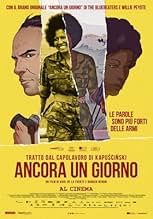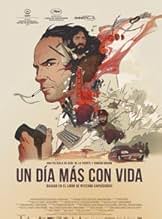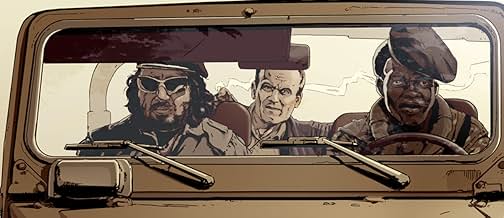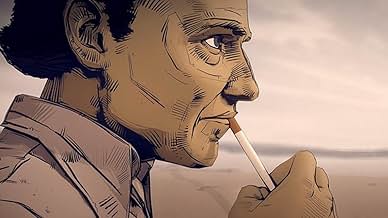IMDb-BEWERTUNG
7,3/10
2906
IHRE BEWERTUNG
Im Jahr 1975, als Portugal als Kolonialmacht abtritt, beginnt am Vorabend der Unabhängigkeit in Angola ein blutiger Bürgerkrieg, in dem es um die postkoloniale Machtverteilung geht.Im Jahr 1975, als Portugal als Kolonialmacht abtritt, beginnt am Vorabend der Unabhängigkeit in Angola ein blutiger Bürgerkrieg, in dem es um die postkoloniale Machtverteilung geht.Im Jahr 1975, als Portugal als Kolonialmacht abtritt, beginnt am Vorabend der Unabhängigkeit in Angola ein blutiger Bürgerkrieg, in dem es um die postkoloniale Machtverteilung geht.
- Auszeichnungen
- 14 Gewinne & 9 Nominierungen insgesamt
Luis Alberto Ferreira
- Self
- (as Luis Alberto)
Carlota Machado
- Self
- (Archivfilmmaterial)
- (as Carlota)
Joaquim António Lopes Farrusco
- Self
- (as Farrusco)
Vergil J. Smith
- Queiroz
- (as Vergil Smith)
- …
Kerry Shale
- Ryszard Kapuscinski
- (Synchronisation)
Daniel Flynn
- Queiroz
- (Synchronisation)
Youssef Kerkour
- Farrusco
- (Synchronisation)
Lillie Flynn
- Carlota
- (Synchronisation)
Akie Kotabe
- Friedkin
- (Synchronisation)
- …
Ben Elliot
- Portuguese soldier
- (Synchronisation)
Emma Tate
- Dona Cartagina
- (Synchronisation)
Empfohlene Bewertungen
Very good movie on the Angola civil war, a subject not often explored in film but full of possibilities as most wars are. But this is a different kind of movie as it uses animation to tell its story while also taking the Band of Brothers way of storytelling, by having the real people who were involved in it say in their own words what happened. It is mostly animation but with live action images scattered throughout, resulting in a very engaging experience. Technically I found the movie breathtakingly beautiful, using a style of animation that I don't particularly like but making the most out of it, creating some beautiful imagery and a realism that I wasn't expecting. Congratulations to the duo directing the movie, really well done. And now I must delve a bit on the political side of this movie. As a Portuguese this is a story that resonates a lot with us because it was a huge deal in our country, full of changes during that period of time. I must address another reviewer here that didn't like the way it made the MPLA look like saints, and he didn't like the movie because of it, he made a lot of valid points but I don't think this movie is as black and white as he makes it seem, sure it is told through the eyes of MPLA supporters, but there are a lot of clues to show that they were no saints, for example, when they are talking about the brother or comrade way of addressing a soldier, they say it's a coin flip and they both will kill you if you address them in the wrong manner, and by the end, the Artur character is extremely disappointed with the way the war turned out, where all their ideals and principals were never upheld, calling into question the whole war, which again shows that the MPLA were not very different from UNITA. And this brings me to our main character, Ryszard Kapuscinski. He was a very well known Polish journalist and writer and upon some research I found that he was not very consensual, as he often took real stories and romanticized them so much to the point of being total inventions. By adapting one of his works the filmmakers made an excellent decision of using the before mentioned technique of mixing animation, to tell the Kapuscinski story, and real live footage, to act as kind of a fact checker about what is being said. Highly recommended.
Rizsard Kapuscinsky is one of the most important reporters of the XX Century, and someone who witnessed some of the biggest war crimes in Europe, Latin America and Africa. His books and reportages are ineludible documents to understand all the interests behind war, invasions and geopolitics. It is not surprise that any American viewer say nothing about this animated documentary. It is very probably that American audiences doesn't like at all what Kapuscinski has written, and the way he is portrayed on here. Very far from the way are portayed reporters Bob Woodward and Carl Bernstein on the Watergate affair. In that case, there is no ideology. America film and history are made to believe that what both Washington Post reporters it is what investigative journalism is all about. This is, for say the least, an arrogant point of view. America is not the world, nor even the center of the word. Is one pole. The other is Russia, and the former USSR.
This animated documentary involves both poles from the Cold War, and is not, and cannot be by any means precisely a fruit of objectivity. But, as Kapuscinski put it in many other of his reporter works, and is put it that way on here, his job is to give word to those are condemned to be forgotten, those who usually die amidst oblivion and never are listen, those who are needed and poor, just like Jesus say on his preach, which not means I compared Jesus with Kapuscinski.
Animation is awesome on this documentary, the way are blended original footage and pictures of many of the depicted characters is just amazing, and shows how American power is capable of the worst atrocities only to support its foreing policy of destruction and empoverity entire countries. The Angola conflict is one of those defeites that American doesn't want to remember, after Vietnam. Of course, it would be naïve to consider that this documentary support openly Russian interventionism, since they abandon too Angola, only to see how Cuba took their place in the conflict and made it to succeed.
There is no such a thing called neutral interventionism, but Kapuscinski knows that he has to be the voice of those who hasn't and seem condemned to be crashed by any outside political power. "This is the way I look" is a frase repeated several times in the documentary, as if little people raise his voice to be remeber in the future and not fall into oblivion. That's the very point on what Kapuscinski was doing all his life, and for that will be remembered as one of the biggest and more influential reporters of the last century.
A very impressive documentary, a must see to unveil our prejudices about interventionism.
This animated documentary involves both poles from the Cold War, and is not, and cannot be by any means precisely a fruit of objectivity. But, as Kapuscinski put it in many other of his reporter works, and is put it that way on here, his job is to give word to those are condemned to be forgotten, those who usually die amidst oblivion and never are listen, those who are needed and poor, just like Jesus say on his preach, which not means I compared Jesus with Kapuscinski.
Animation is awesome on this documentary, the way are blended original footage and pictures of many of the depicted characters is just amazing, and shows how American power is capable of the worst atrocities only to support its foreing policy of destruction and empoverity entire countries. The Angola conflict is one of those defeites that American doesn't want to remember, after Vietnam. Of course, it would be naïve to consider that this documentary support openly Russian interventionism, since they abandon too Angola, only to see how Cuba took their place in the conflict and made it to succeed.
There is no such a thing called neutral interventionism, but Kapuscinski knows that he has to be the voice of those who hasn't and seem condemned to be crashed by any outside political power. "This is the way I look" is a frase repeated several times in the documentary, as if little people raise his voice to be remeber in the future and not fall into oblivion. That's the very point on what Kapuscinski was doing all his life, and for that will be remembered as one of the biggest and more influential reporters of the last century.
A very impressive documentary, a must see to unveil our prejudices about interventionism.
An animated film, spliced in parts, with real documentary film of interviews with important subjects within the animated tale. Rizsard Kapuscinsky was an exceptionally gifted, brave and heroic reporter. He reported the facts and truth of the corrupt cold war slaughterhouse being waged by America and Russia in the African backyard of Angola. A war, which this film bio informs us of, where both sides - the MPLA and the NFLA - murdered millions and committed despicable atrocities!
The animated sections are in the English language and the actual documentary pieces are in native tongues; but there are subtitles available so that you know what is said. It makes for a gripping and most thoroughly interesting watch and, is presented in an almost comic style very polished looking animated style. There is no one sided reporting as it tells the tale of the misery caused by both side and both superpowers; a misery that endured for the Angolan people for 27 years.
The animated sections are in the English language and the actual documentary pieces are in native tongues; but there are subtitles available so that you know what is said. It makes for a gripping and most thoroughly interesting watch and, is presented in an almost comic style very polished looking animated style. There is no one sided reporting as it tells the tale of the misery caused by both side and both superpowers; a misery that endured for the Angolan people for 27 years.
An interesting and gripping animated documentary co-produced by Spain , Germany and Poland , dealing with the Angolan Civil War (Portuguese: Guerra Civil Angolana) , was a civil war in Angola, beginning in 1975 and continuing, with interludes, until 2002. The 27-year war can be divided roughly into three periods of major fighting - from 1975 to 1991, 1992 to 1994 and from 1998 to 2002 - with fragile periods of peace. By the time the MPLA achieved victory in 2002, more than 500,000 people had died and over one million had been internally displaced . The war began immediately after Angola became independent from Portugal in November 1975 . Regarding a three-month-long journey that renowned Polish reporter Ryszard Kapuscinski took across Angola ravaged by a war in which the front lines shifted like a kaleidoscope from one day to the next . On the frontlines , Kapuscinski is working under immense pressure, terror and loneliness a staple of his daily routine. Based on the literary original, the audience will begin their journey with Kapuscinski in 1975 Luanda, the capital of Angola. Involving both poles from the Cold War: Communist bloc and Capitalist faction . Kapuscinski decides to journey to the front lines of the war , traveling through the conflict zone resembles a game of Russian roulette : even uttering the wrong greeting at a checkpoint can get him killed . To tell the true story of Angola , he undergoes a deep change as a human being and he is reborn as a thought-provoking writer . The conflict has a human face - the face of the fierce fighter Carlotta and comendante Farrusco , two of many acquaintances he's made during his journeys to the frontlines . To risk his life in order to be the first journalist in the world to broadcast daily reports on the course of the conflict . An internal conflict is raging within the writer - Kapuscinski is unable and unwilling to be simply a passive , objective observer of the events taking place all around him . ¨Another Day of Life¨ has documentary sequences , lending credibility enough to the world depicted in the animation and giving the spectators a chance to meet the characters 40 years after the events portrayed in the movie , as well as a really additional depth. The picture was well directed Raúl de la Fuente, Damian Nenow who also wrote and based on the book by Kapuscinsky .
The film is well based on historical events , these are as follows : The country is in the midst of decolonization efforts, launched after the success of the Carnation Revolution. Portuguese nationals are hurriedly fleeing the more glamorous districts of Luanda. The war devastated Angola's infrastructure and severely damaged public administration, the economy and religious institutions.In the final months before the declaration of independence, different factions of the Angolan liberation movement were locked in a protracted struggle that would decide who would hold power in the coming republic. The war was a power struggle between two former anti-colonial guerrilla movements, the communist People's Movement for the Liberation of Angola (MPLA) and the anti-communist National Union for the Total Independence of Angola (UNITA). The war was used as a surrogate battleground for the Cold War by rival states such as the Soviet Union, Cuba, South Africa and the United States.The MPLA and UNITA had different roots in Angolan society and mutually incompatible leaderships, despite their shared aim of ending colonial rule. A third movement, the National Front for the Liberation of Angola (FNLA), having fought the MPLA with UNITA during the war for independence, played almost no role in the Civil War. Additionally, the Front for the Liberation of the Enclave of Cabinda (FLEC), an association of separatist militant groups, fought for the independence of the province of Cabinda from Angola.The Angolan Civil War was notable due to the combination of Angola's violent internal dynamics and the exceptional degree of foreign military and political involvement. The war is widely considered a Cold War proxy conflict, as the Soviet Union and the United States, with their respective allies, provided assistance to the opposing factions. The conflict became closely intertwined with the Second Congo War in the neighbouring Democratic Republic of the Congo and the South African Border War.Angola's three rebel movements had their roots in the anti-colonial movements of the 1950s.The MPLA was primarily an urban based movement in Luanda and its surrounding area.It was largely composed of Mbundu people. By contrast the other two major anti-colonial movements the FNLA and UNITA, were rurally based groups.The FNLA largely consisted of Bakongo people hailing from Northern Angola. UNITA, an offshoot of the FNLA, was mainly composed of Ovimbundu people from the Central highlands
MPLA : Since its formation in the 1950s, the MPLA's main social base has been among the Ambundu people and the multiracial intelligentsia of cities such as Luanda, Benguela and Huambo.During its anti-colonial struggle of 1962-74, the MPLA was supported by several African countries, as well as by the Soviet Union. Cuba became the MPLA's strongest ally, sending significant contingents of combat and support personnel to Angola. This support, as well as that of several other countries of the Eastern Bloc, was maintained during the Civil War. Communist Yugoslavia provided financial military support for the MPLA, including $14 million in 1977, as well as Yugoslav security personnel in the country and diplomatic training for Angolans in Belgrade. The United States Ambassador to Yugoslavia wrote of the Yugoslav relationship with the MPLA, and remarked, "Tito clearly enjoys his role as patriarch of guerrilla liberation struggle." Agostinho Neto, MPLA's leader during the civil war, declared in 1977 that Yugoslav aid was constant and firm, and described the help as extraordinary. According to a November 1978 special communique, Portuguese troops were among the 20,000 MPLA troops that participated in a major offensive in central and southern Angola
UNITA's main social basis were the Ovimbundu of central Angola, who constituted about one third of the country's population, but the organization also had roots among several less numerous peoples of eastern Angola. UNITA was founded in 1966 by Jonas Savimbi, who until then had been a prominent leader of the FNLA. During the anti-colonial war, UNITA received some support from the People's Republic of China. With the onset of the civil war, the United States decided to support UNITA and considerably augmented their aid to UNITA in the decades that followed. However, in the latter period, UNITA's main ally was the apartheid regime of South Africa
The film is well based on historical events , these are as follows : The country is in the midst of decolonization efforts, launched after the success of the Carnation Revolution. Portuguese nationals are hurriedly fleeing the more glamorous districts of Luanda. The war devastated Angola's infrastructure and severely damaged public administration, the economy and religious institutions.In the final months before the declaration of independence, different factions of the Angolan liberation movement were locked in a protracted struggle that would decide who would hold power in the coming republic. The war was a power struggle between two former anti-colonial guerrilla movements, the communist People's Movement for the Liberation of Angola (MPLA) and the anti-communist National Union for the Total Independence of Angola (UNITA). The war was used as a surrogate battleground for the Cold War by rival states such as the Soviet Union, Cuba, South Africa and the United States.The MPLA and UNITA had different roots in Angolan society and mutually incompatible leaderships, despite their shared aim of ending colonial rule. A third movement, the National Front for the Liberation of Angola (FNLA), having fought the MPLA with UNITA during the war for independence, played almost no role in the Civil War. Additionally, the Front for the Liberation of the Enclave of Cabinda (FLEC), an association of separatist militant groups, fought for the independence of the province of Cabinda from Angola.The Angolan Civil War was notable due to the combination of Angola's violent internal dynamics and the exceptional degree of foreign military and political involvement. The war is widely considered a Cold War proxy conflict, as the Soviet Union and the United States, with their respective allies, provided assistance to the opposing factions. The conflict became closely intertwined with the Second Congo War in the neighbouring Democratic Republic of the Congo and the South African Border War.Angola's three rebel movements had their roots in the anti-colonial movements of the 1950s.The MPLA was primarily an urban based movement in Luanda and its surrounding area.It was largely composed of Mbundu people. By contrast the other two major anti-colonial movements the FNLA and UNITA, were rurally based groups.The FNLA largely consisted of Bakongo people hailing from Northern Angola. UNITA, an offshoot of the FNLA, was mainly composed of Ovimbundu people from the Central highlands
MPLA : Since its formation in the 1950s, the MPLA's main social base has been among the Ambundu people and the multiracial intelligentsia of cities such as Luanda, Benguela and Huambo.During its anti-colonial struggle of 1962-74, the MPLA was supported by several African countries, as well as by the Soviet Union. Cuba became the MPLA's strongest ally, sending significant contingents of combat and support personnel to Angola. This support, as well as that of several other countries of the Eastern Bloc, was maintained during the Civil War. Communist Yugoslavia provided financial military support for the MPLA, including $14 million in 1977, as well as Yugoslav security personnel in the country and diplomatic training for Angolans in Belgrade. The United States Ambassador to Yugoslavia wrote of the Yugoslav relationship with the MPLA, and remarked, "Tito clearly enjoys his role as patriarch of guerrilla liberation struggle." Agostinho Neto, MPLA's leader during the civil war, declared in 1977 that Yugoslav aid was constant and firm, and described the help as extraordinary. According to a November 1978 special communique, Portuguese troops were among the 20,000 MPLA troops that participated in a major offensive in central and southern Angola
UNITA's main social basis were the Ovimbundu of central Angola, who constituted about one third of the country's population, but the organization also had roots among several less numerous peoples of eastern Angola. UNITA was founded in 1966 by Jonas Savimbi, who until then had been a prominent leader of the FNLA. During the anti-colonial war, UNITA received some support from the People's Republic of China. With the onset of the civil war, the United States decided to support UNITA and considerably augmented their aid to UNITA in the decades that followed. However, in the latter period, UNITA's main ally was the apartheid regime of South Africa
This movie is like two movies in one. Part of it is a documentary about the Angolan Civil War. The other part is an animated film about the same subject, following Polish journalist Ryszard Kapuscinski reporting on the war in the 1970s. The first thing that I need to talk about is the animation. It is animated in that rotoscoped cell-shaded CGI style similar to A Scanner Darkly or the Love, Death & Robots short Fish Night. Normally, I hate animation that is trying to look realistic, but I didn't mind it here. There are many sequences of animation in this movie that just couldn't possibly work as well in live-action. The colours are really nice and it is intense! It actually feels like you're in the middle of a war! The story I found very interesting and the intercut documentary footage of people who actually knew the main character in real life and are characters in the movie themselves was really cool and helped with my understanding of the story and the history behind the film. The acting was really good as well and I really cared about the characters. Overall, if you like animation or historical war movies, you should watch this movie. It's very short, but very good!
Wusstest du schon
- WissenswertesIt took 10 years to make the movie.
- PatzerIn the animated sequences of the South African army invading southern Angola, they are shown having American helicopters such as the Huey and Chinook.
In reality they had helicopters of French design, such as the Aloutte and Puma.
- Zitate
Ryszard Kapuscinski: It's a special kind of oppressiveness we feel now. Because this is a lesson drawn from history. That blood will flow.
- VerbindungenFeatured in Premios Goya 33 edición (2019)
Top-Auswahl
Melde dich zum Bewerten an und greife auf die Watchlist für personalisierte Empfehlungen zu.
- How long is Another Day of Life?Powered by Alexa
Details
- Erscheinungsdatum
- Herkunftsländer
- Offizielle Standorte
- Sprachen
- Auch bekannt als
- Un día más con vida
- Drehorte
- Kuba(location)
- Produktionsfirmen
- Weitere beteiligte Unternehmen bei IMDbPro anzeigen
Box Office
- Budget
- 7.700.000 € (geschätzt)
- Bruttoertrag in den USA und Kanada
- 3.190 $
- Eröffnungswochenende in den USA und in Kanada
- 1.691 $
- 15. Sept. 2019
- Weltweiter Bruttoertrag
- 134.801 $
- Laufzeit
- 1 Std. 25 Min.(85 min)
- Farbe
Zu dieser Seite beitragen
Bearbeitung vorschlagen oder fehlenden Inhalt hinzufügen




























